
|
|
Font Size:
|
||||
|
|
|
|
||||
STATISTICAL BRIEF #99:
Trends in Children's Health Insurance Coverage for Families with Children, 1996-2002 (First Half)
Highlights
- In the first part of 2002, 86.6 percent of families had at least one child who was insured and 16.2 percent of families had at least one child who was uninsured--a three percentage point increase and decrease, respectively, since the first part of 1996.
- Increases in the percentage of families with an insured child were primarily due to increases in insurance for families with incomes below 200 percent of the Federal poverty level.
- Decreases in the percentage of families with an uninsured child are more dramatic in families with incomes below 200 percent of the Federal poverty level.
- In the first part of 2002, 59.6 percent of families had all their children covered by private insurance, 21.2 percent had all their children covered by public insurance, and 13.4 percent had all uninsured children and 5.8 percent had children in the same family with different types of insurance coverage.
- Families where all children were covered by public insurance increased by five percentage points and those with all uninsured children dropped by three percentage points between the first parts of 1996 and 2002.
Introduction
Health insurance for children in the United States is typically determined at the family level. Children covered by private insurance are covered by their parents through family plans that cover all children in the family or by adult-plus-one plans that cover one adult and one child. Eligibility for public insurance relies heavily on family-level income and family size. Nevertheless, statistics for children's health insurance status are often reported at the person (child) level. Family-level statistics provide a different aspect on children's insurance status. They have the potential to differ from child-level statistics because families often have multiple children in the same household, with each child having his or her own insurance status. When families have multiple children with different types of insurance coverage or have varying concentrations of children with the same type of coverage, they provide additional information for researchers that is not available at the child level.
This Statistical Brief presents data from the Household Component of the Medical Expenditure Panel Survey (MEPS-HC) for the first part of calendar years 1996 through 2002 on children's health insurance coverage for families with children. All estimates in the brief are presented at the family level and include only those families with children ages 18 and under.1 For ease of presentation, the word "family" will be used to represent families with children age 18 and under. For this analysis, families are constructed to include adults and children who would typically be eligible for coverage under the adults' private health insurance family plans (for example, children and their parents).
Children's health insurance status at the family level is reported using a variety of statistics. The prevalence of insurance (and uninsurance) is reported for families where at least one child is insured (or uninsured). A more detailed coverage measure reports children's insurance status across four categories: 1) families where all children are covered by private insurance, 2) families where all children are covered by public insurance, 3) families where all children are uninsured, and 4) families where children in the same family have different types of insurance coverage (for example, one child may be uninsured, while another is covered by public insurance).
All differences between estimates discussed in the text are statistically significant at the 0.05 level unless otherwise noted.
Findings
In the first part of 2002, 86.6 percent (figure 1) of U.S. families had at least one child covered by health insurance (36.6 million families, not shown). This represents a significant increase of almost 3 percentage points since the first part of 1996, when 83.7 percent of families had an insured child (33.3 million, not shown). Much of the increase in insurance was driven by families with incomes below 200 percent of the Federal poverty level (FPL). The percentage of families with an insured child increased seven percentage points between the first parts of 1996 and 2002 among families with incomes below 200 percent of FPL (75.4 percent to 81.6 percent) but remained stable for families with incomes above 200 percent of FPL (at about 88.9 percent) (figure 2).
During the same time period, the number and percentage of families with at least one uninsured child dropped significantly (figure 1): 19.3 percent of families had an uninsured child in the first part of 1996 (7.7 million, not shown) versus only 16.2 percent of families in the first part of 2002 (6.8 million, not shown). Mirroring trends for insurance, this decrease was primarily driven by families with incomes below 200 percent of FPL. In the first part of 1996, 29.4 percent of families with incomes below 200 percent of FPL had an uninsured child versus only 23.4 percent in the first part of 2002 (figure 3). For families above 200 percent of FPL, the percentage of families with an uninsured child was stable at about 12.6 percent.
In the first part of 2002, 86.6 percent of families had children who were covered by either private or public insurance; 25.1 million (not shown) or 59.6 percent of families had all children covered by private insurance (figure 4). Alternatively, 9.0 million (not shown), or 21.2 percent had all children covered by public insurance. Only 13.4 percent of families, or 5.6 million (not shown), had all children uninsured for the entire first part of 2002. A small percentage of families (5.8 percent) had children with differing types of insurance coverage. All 2.5 million (not shown) of these families had at least one insured child (either public or private or both), but almost half of these families, 1.1 million, also had at least one uninsured child.
In comparison to children's insurance status for families in the first part of 1996, increases in insurance rates for families with children in the first part of 2002 were driven by increases in families with public coverage (figure 5). Despite the stability in estimates of private coverage between the first parts of 1996 and 2002 (62.4 percent to 59.6 percent), the percentage of families with all uninsured children fell by three percentage points (16.3 percent to 13.4 percent). Increases in public coverage compensated for the drop in private coverage, with a five percentage point increase from 16.1 percent to 21.2 percent. These changes coincided with expansions in public insurance through the State Children's Health Insurance Program and Medicaid and increased take-up of public insurance for Medicaid-eligible children.2
Data Source
The estimates provided in this Statistical Brief come from the 1996 through 2002 MEPS-HC files (HC01, HC-05, HC-09, HC-13, HC-22, HC-34, and HC-53) with point-in-time estimates for the early part of calendar years 1996 through 2002 for Round 1 persons in Panels 1 through 7 and Round 3 persons in Panels 1, 2 and 4 through 6. The point-in-time MEPS-HC files contain data on family structure, employment, health insurance, health status, and demographic characteristics of both individuals and households for the first part of the calendar year.
Definitions
Family
Families are constructed to include adults and those family members who would typically be eligible for coverage under the adults' private health insurance family plans, a grouping otherwise known as health insurance eligibility units (HIEUs). These families comprise adults, their spouses, and their unmarried natural/adoptive children age 18 and under. Unmarried minors living without their natural/adoptive parents are included in the family of their stepparent, grandparent or aunt/uncle. Married minor children are placed in a separate family with their spouses and their own children. Children of unmarried minors are placed, along with their minor parent, in the family of their adult grandparents. Foster children and unmarried minors living without any adult family member constitute their own independent families without adults.
Age
Children are ages 18 and under. Note that some other MEPS Statistical Briefs use different age ranges for children and adults and will report slightly different estimates for insurance status.
Insurance status for children
Insurance status for children is measured over the current round of the survey. In these files, the round took place in the first part of calendar years 1996 through 2002. Individual insurance coverage is defined by the following mutually exclusive categories: 1) both public and private insurance during the round, 2) any private insurance during the round, 3) any public insurance during the round, and 4) uninsured for entire round. These categories do not overlap, so a child with both public and private insurance during the round would appear in category 1 but would not appear in categories 2 or 3.
Insurance status for families
Insurance status for families is based on the insurance status of the children within each family and, therefore, also reflects coverage over the current round of the survey. This represents coverage in families for the first part of calendar years 1996 through 2002. Family-level insurance coverage is defined by the following mutually exclusive categories describing insurance coverage for children within the family: 1) all children covered by private insurance at some point in the round, 2) all children covered by public insurance at some point in the round, 3) all children uninsured for the entire round, and 4) children in the same family with differing insurance coverage. Category 4 includes two types of families: those with a child who was covered by both public and private insurance during the round and, more commonly, those who had two or more children with different types of coverage in the round. For example, a family might have one child who was covered by public insurance at some point during the round and another child who was uninsured for the entire round.
Statistics on families with at least one insured (or uninsured child) are not mutually exclusive. They measure A) whether there was at least one child in the family who had insurance at any point in the round and B) whether there was at least one child in the family who was uninsured for the entire round. If a family has a one child who was covered by public insurance and another child who was uninsured, they would be represented in categories A and B.
Federal poverty level
Family income and size are used to calculate the Federal poverty level. Individual incomes are measured by taking annual earned income and unearned income for each family member and are summed across all family members to get family income. Family income and size are used to obtain the Federal poverty level for each family.
About MEPS-HC
MEPS-HC is a nationally representative longitudinal survey that collects detailed information on health care utilization and expenditures, health insurance, and health status, as well as a wide variety of social, demographic, and economic characteristics for the civilian noninstitutionalized population. It is cosponsored by the Agency for Healthcare Research and Quality and the National Center for Health Statistics.
For more information about MEPS, call the MEPS information coordinator at AHRQ (301-427-1656) or visit the MEPS Web site at http://www.meps.ahrq.gov/.
References
For a detailed description of the MEPS survey design, sample design, and methods used to minimize sources of nonsampling error, see the following publications:
Cohen, J. Design and Methods of the Medical Expenditure Panel Survey Household Component. MEPS Methodology Report No. 1. AHCPR Pub. No. 97-0026. Rockville, Md.: Agency for Health Care Policy and Research, 1997.
Cohen, S. Sample Design of the 1996 Medical Expenditure Panel Survey Household Component. MEPS Methodology Report No. 2. AHCPR Pub. No. 97-0027. Rockville, Md.: Agency for Health Care Policy and Research, 1997.
Cohen, S. Design Strategies and Innovations in the Medical Expenditure Panel Survey. Medical Care, July 2003: 41(7) Supplement: III-5-III-12.
Suggested Citation
Hudson, J. L. Trends in Children's Health Insurance Coverage for Families with Children, 1996-2002. Statistical Brief #99. September 2005. Agency for Healthcare Research and Quality, Rockville, Md. http://meps.ahrq.gov/mepsweb/data_files/publications/st99/stat99.shtml
AHRQ welcomes questions and comments from readers of this publication who are interested in obtaining more information about access, cost, use, financing, and quality of health care in the United States. We also invite you to tell us how you are using this Statistical Brief and other MEPS data and tools and to share suggestions on how MEPS products might be enhanced to further meet your needs. Please e-mail us at mepspd@ahrq.gov or send a letter to the address below:
Steven B. Cohen, PhD
Director
Center for Financing, Access, and Cost Trends
Agency for Healthcare Research and Quality
540 Gaither Road
Rockville, MD 20850
Footnotes
1 Statistical Brief #85, Health Insurance Status of Children in America, 1996-2004: Estimates for the U.S. Civilian Noninstitutionalized Population under Age 18, presents MEPS estimates for children's health insurance at the person level.
2 Selden, T. M., Hudson, J. L. and Banthin, J. S. Tracking Changes in Eligibility and Coverage among Children, 1996-2002. Health Affairs 23, no. 5 (2004): 39-50.
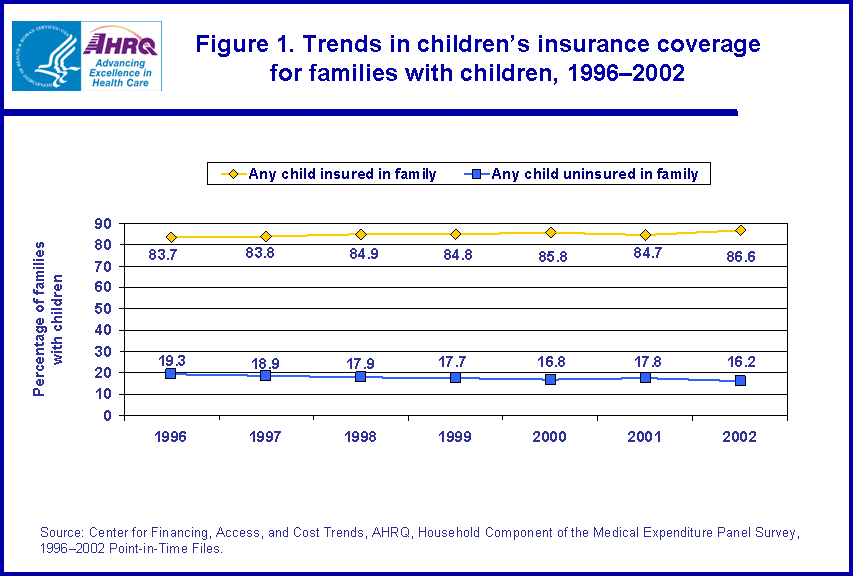 |
||||||||||||||||||||||||||||||||||||||||||||||||
|
||||||||||||||||||||||||||||||||||||||||||||||||
|
|
||||||||||||||||||||||||||||||||||||||||||||||||
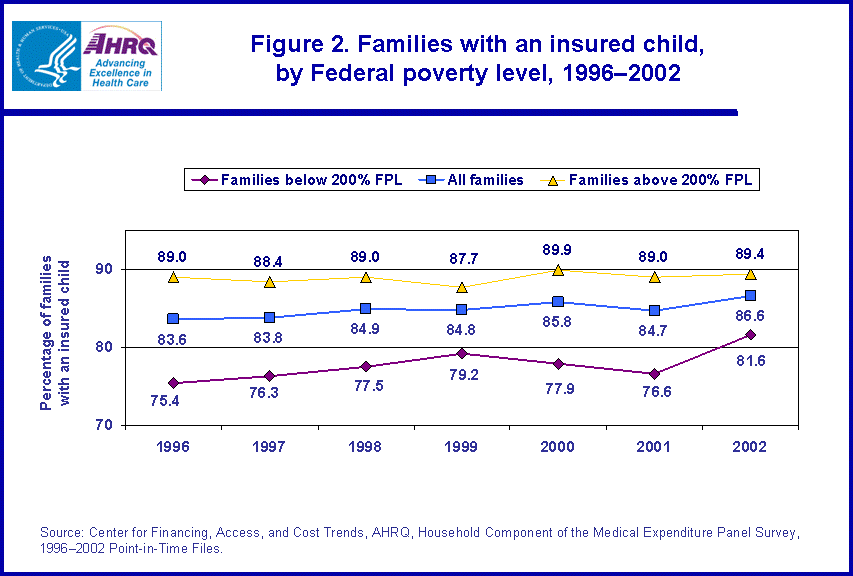 |
||||||||||||||||||||||||||||||||||||||||||||||||
|
||||||||||||||||||||||||||||||||||||||||||||||||
|
|
||||||||||||||||||||||||||||||||||||||||||||||||
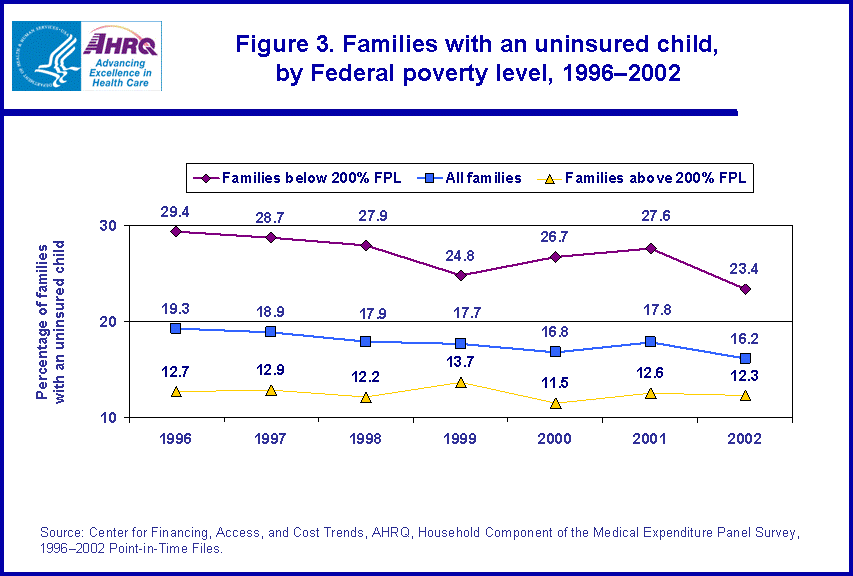 |
||||||||||||||||||||||||||||||||||||||||||||||||
|
||||||||||||||||||||||||||||||||||||||||||||||||
|
|
||||||||||||||||||||||||||||||||||||||||||||||||
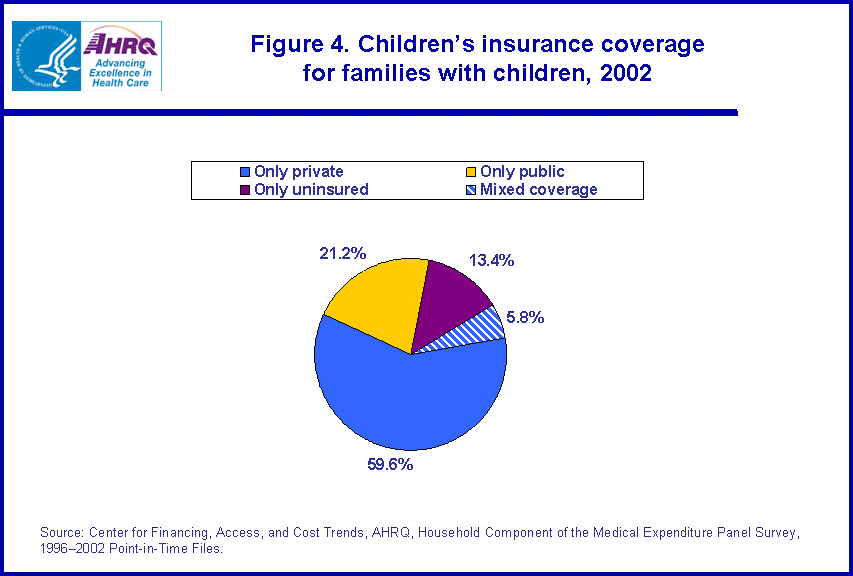 |
||||||||||||||||||||||||||||||||||||||||||||||||
|
||||||||||||||||||||||||||||||||||||||||||||||||
|
|
||||||||||||||||||||||||||||||||||||||||||||||||
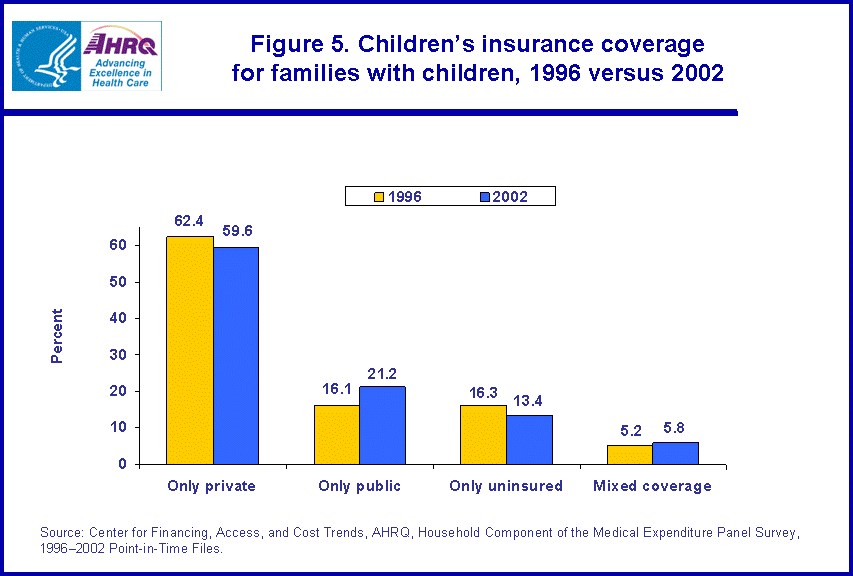 |
||||||||||||||||||||||||||||||||||||||||||||||||
|
||||||||||||||||||||||||||||||||||||||||||||||||
|
|
||||||||||||||||||||||||||||||||||||||||||||||||


